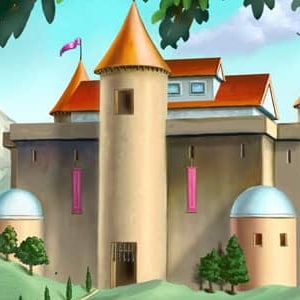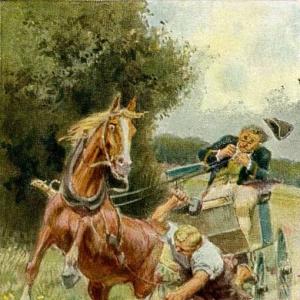Reading time: 7 min
A long time ago, there lived an old poet, a thoroughly kind old poet. As he was sitting one evening in his room, a dreadful storm arose without, and the rain streamed down from heaven; but the old poet sat warm and comfortable in his chimney-comer, where the fire blazed and the roasting apple hissed.
„Those who have not a roof over their heads will be wetted to the skin,“ said the good old poet.
„Oh let me in! Let me in! I am cold, and I’m so wet!“ exclaimed suddenly a child that stood crying at the door and knocking for admittance, while the rain poured down, and the wind made all the windows rattle.
„Poor thing!“ said the old poet, as he went to open the door. There stood a little boy, quite naked, and the water ran down from his long golden hair. He trembled with cold, and had he not come into a warm room he would most certainly have perished in the frightful tempest.
„Poor child!“ said the old poet, as he took the boy by the hand. „Come in, come in, and I will soon restore thee! Thou shalt have wine and roasted apples, for thou art verily a charming child!“
And the boy was so really. His eyes were like two bright stars; and although the water trickled down his hair, it waved in beautiful curls. He looked exactly like a little angel, but he was so pale, and his whole body trembled with cold. He had a nice little bow in his hand, but it was quite spoiled by the rain, and the tints of his many-colored arrows ran one into the other.
The old poet seated himself beside his hearth, and took the little fellow on his lap. He squeezed the water out of his dripping hair, warmed his hands between his own, and boiled for him some sweet wine. Then the boy recovered, his cheeks again grew rosy, he jumped down from the lap where he was sitting, and danced round the kind old poet.
„You are a merry fellow,“ said the old man. „What’s your name?“
„My name is Cupid,“ answered the boy. „Don’t you know me? There lies my bow. It shoots well, I can assure you! Look, the weather is now clearing up, and the moon is shining clear again through the window.“
„Why, your bow is quite spoiled,“ said the old poet.
„That were sad indeed,“ said the boy, and he took the bow in his hand -and examined it on every side. „Oh, it is dry again, and is not hurt at all. The string is quite tight. I will try it directly.“ And he bent his bow, took aim, and shot an arrow at the old poet, right into his heart. „You see now that my bow was not spoiled,“ said he laughing; and away he ran. The naughty boy, to shoot the old poet in that way. He who had taken him into his warm room, who had treated him so kindly, and who had given him warm wine and the very best apples!
The poor poet lay on the earth and wept, for the arrow had really flown into his heart. „Fie!“ said he. „How naughty a boy Cupid is! I will tell all children about him, that they may take care and not play with him, for he will only cause them sorrow and many a heartache.“
And all good children to whom he related this story, took great heed of this naughty Cupid; but he made fools of them still, for he is astonishingly cunning. When the university students come from the lectures, he runs beside them in a black coat, and with a book under his arm. It is quite impossible for them to know him, and they walk along with him arm in arm, as if he, too, were a student like themselves; and then, unperceived, he thrusts an arrow to their bosom. When the young maidens come from being examined by the clergyman, or go to church to be confirmed, there he is again close behind them. Yes, he is forever following people. At the play, he sits in the great chandelier and burns in bright flames, so that people think it is really a flame, but they soon discover it is something else. He roves about in the garden of the palace and upon the ramparts: yes, once he even shot your father and mother right in the heart. Ask them only and you will hear what they’ll tell you. Oh, he is a naughty boy, that Cupid. You must never have anything to do with him. He is forever running after everybody. Only think, he shot an arrow once at your old grandmother! But that is a long time ago, and it is all past now. However, a thing of that sort she never forgets. Fie, naughty Cupid! But now you know him, and you know, too, how ill-behaved he is!
 Learn languages. Double-tap on a word.Learn languages in context with Childstories.org and Deepl.com.
Learn languages. Double-tap on a word.Learn languages in context with Childstories.org and Deepl.com.Backgrounds
Interpretations
Adaptions
Summary
Linguistics
„The Naughty Boy“ is a lesser-known fairy tale by Danish author Hans Christian Andersen, who is famous for his classic stories such as „The Little Mermaid,“ „The Ugly Duckling,“ and „The Emperor’s New Clothes.“ Andersen was born on April 2, 1805, in Odense, Denmark, and died on August 4, 1875, in Copenhagen. Throughout his life, he published numerous collections of fairy tales and stories, which have been translated into more than 150 languages and have captivated generations of readers around the world.
Andersen’s fairy tales often contain moral lessons and explore various themes, such as love, innocence, beauty, and human nature. „The Naughty Boy“ is no exception, as it delves into the complexities of love and trust, as well as the duality of human nature. Although the story features the mythological figure Cupid, the god of love, it is primarily a cautionary tale that uses this character to illustrate the unpredictable and mischievous aspects of love.
Andersen’s unique storytelling style combines elements of realism and fantasy, creating a world where ordinary people encounter extraordinary events and creatures. In „The Naughty Boy,“ the old poet, a seemingly ordinary character, finds himself at the mercy of Cupid’s whims, highlighting the fantastical element of the tale. This combination of realism and fantasy has become one of the hallmarks of Andersen’s work, contributing to the enduring appeal of his stories.
„The Naughty Boy“ can be interpreted in several ways, offering different insights into the themes of love, trust, and human nature.
Love’s unpredictable nature: The story highlights the unpredictable and uncontrollable nature of love. Just like Cupid’s mischief, love can strike anyone at any time, often causing emotional turmoil and heartache. The story suggests that people should be cautious when dealing with love, as it can be both a source of joy and pain.
The duality of human nature: Cupid’s character embodies both innocence and mischief, symbolizing the duality of human nature. The story demonstrates that people are capable of both kindness and cruelty, and that appearances can be deceiving. This theme encourages readers to be cautious when trusting others, as their intentions may not always be clear.
The transformative power of love: The old poet’s decision to warn children about Cupid can be seen as a metaphor for the transformative power of love. The poet’s experience with Cupid changes him, making him more cautious and skeptical about love. This change reflects the way that love can impact and transform people’s lives in various ways.
The resilience of love: Despite the old poet’s efforts to warn others about Cupid, the mischievous god continues to cause heartache and sorrow. This persistence can be interpreted as a testament to the resilience and enduring nature of love. No matter how much people try to avoid or control it, love will always find a way to affect their lives.
The power of storytelling: The old poet uses storytelling as a means to communicate the dangers of Cupid and to educate others about the potential consequences of love. This highlights the power of stories to teach valuable life lessons, impart wisdom, and influence the way people perceive the world around them.
„The Naughty Boy“ by Hans Christian Andersen has inspired several adaptations in different forms of media, including:
Theater productions: „The Naughty Boy“ has been adapted for the stage in various productions. For example, in 2012, the Open Air Theater in London staged a production of „The Little Mermaid and Other Tales,“ which included a performance of „The Naughty Boy.“
Animated films: „The Naughty Boy“ has been adapted into several animated films, including a 1956 Soviet film titled „The Naughty Boy“ and a 1975 Czechoslovakian film titled „The Naughty Boy and the Robber.“
Children’s books: „The Naughty Boy“ has been adapted into several children’s books, including a 2014 picture book adaptation by John Cech and illustrated by Martin Hargreaves.
Radio plays: „The Naughty Boy“ has been adapted into several radio plays, including a 2017 adaptation by BBC Radio 4.
Music: „The Naughty Boy“ has also inspired musical adaptations, including a song by the British indie rock band The Delgados, which appears on their 2000 album „The Great Eastern.“
These adaptations often reinterpret or expand upon the themes of the original story, and may cater to different audiences depending on the medium and format of the adaptation.
„The Naughty Boy“ is a fairy tale by Hans Christian Andersen that tells the story of a kind-hearted old poet who provides shelter to a little boy named Cupid during a stormy night. As the rain pours down, the poet brings the shivering boy into his warm room, dries his wet clothes, and gives him wine and roasted apples to help him recover. The boy, whose eyes sparkle like stars and whose hair curls beautifully, introduces himself as Cupid, the god of love.
Cupid’s bow and arrows appear to be damaged by the rain, but he soon discovers that they are still functional. To prove it, he shoots an arrow straight into the heart of the old poet who had just saved his life. Cupid laughs and runs away, leaving the old poet heartbroken and in pain.
The old poet decides to warn all good children about Cupid’s mischief and deceit, urging them to be cautious around him. However, Cupid continues to cause heartache and sorrow by disguising himself in various forms, such as a student or a flame in a chandelier. He even admits to shooting the hearts of the children’s parents and their grandmother in the past.
In conclusion, „The Naughty Boy“ is a cautionary tale about the mischievous and cunning nature of Cupid, the god of love. Despite the efforts of the old poet to warn others, Cupid continues to inflict pain and heartache upon unsuspecting individuals with his sly tricks and enchanted arrows.
Linguistic analysis of „The Naughty Boy“ by Hans Christian Andersen reveals several key elements that contribute to the fairy tale’s narrative style and thematic depth.
Narrative Voice and Tone: The story is told by an omniscient narrator, which is typical of fairy tales. This allows the narrator to present both the external actions and the internal states of the characters, such as the old poet’s kindness and the boy’s mischief. The tone is gentle and whimsical, which is often the case with Andersen’s stories, despite the underlying serious themes.
Characterization Through Dialogue and Description: The characters are brought to life through both dialogue and descriptive language. The old poet is characterized by his kindness and generosity, as shown in his words and actions towards the seemingly helpless boy. Cupid, initially described with angelic beauty, reveals his true mischievous nature through his actions and dialogue.
Symbolism: The figure of Cupid is rich with symbolic meaning. Traditionally, Cupid is the Roman god of love, often depicted as a playful, mischievous child. Andersen’s depiction aligns with this but adds a layer of mischief that highlights the irrational and unpredictable nature of love. The bow and arrows are central symbols, representing the sudden, piercing nature of love and desire, which often come unbidden and cause unforeseen consequences.
Motifs of Nature and Weather: Andersen’s use of weather motifs, like the storm and the clearing sky, serves as a metaphor for the tumultuous nature of emotions and the sudden onset of love and passion. The transformation from storm to calm parallels the transition from the boy’s pitiable condition to his true, troublesome nature.
Language and Style: Andersen’s language is simple yet evocative, characteristic of fairy tales designed to appeal to both children and adults. The use of direct speech and exclamations („Oh let me in! Let me in!“) brings immediacy and urgency to the narrative, while the descriptive passages create vivid imagery.
Moral and Didactic Elements: The story carries a didactic message typical of fairy tales. It serves as a cautionary tale about the dangers of succumbing to unexamined emotions—symbolized by Cupid’s arrows—and suggests skepticism towards seemingly innocent appearances. The narrator’s admonishments about Cupid’s antics function as both warning and metaphor for the capricious nature of love itself.
Contrast and Irony: Andersen employs irony to deepen the narrative. The old poet’s act of kindness is repaid with mischief, illustrating the unpredictable nature of love and trust. The boy’s transformation from a needy child to a mischievous god serves as a contrast that underscores the theme of deception and hidden realities.
Overall, „The Naughty Boy“ exemplifies Andersen’s skill in blending whimsical storytelling with deeper moral and philosophical questions about human emotions and relationships. The simple narrative style, rich with symbolic meaning, invites reflection on the complexities of love and the duality of innocence and mischief.
Information for scientific analysis
Fairy tale statistics | Value |
|---|---|
| Translations | DE, EN, DA, ES, IT, NL |
| Readability Index by Björnsson | 24.1 |
| Flesch-Reading-Ease Index | 86.8 |
| Flesch–Kincaid Grade-Level | 4.7 |
| Gunning Fog Index | 7.3 |
| Coleman–Liau Index | 7.3 |
| SMOG Index | 7.6 |
| Automated Readability Index | 4.1 |
| Character Count | 4.343 |
| Letter Count | 3.288 |
| Sentence Count | 59 |
| Word Count | 839 |
| Average Words per Sentence | 14,22 |
| Words with more than 6 letters | 83 |
| Percentage of long words | 9.9% |
| Number of Syllables | 1.047 |
| Average Syllables per Word | 1,25 |
| Words with three Syllables | 34 |
| Percentage Words with three Syllables | 4.1% |

 Facebook
Facebook  Whatsapp
Whatsapp  Messenger
Messenger  Telegram
Telegram Reddit
Reddit














